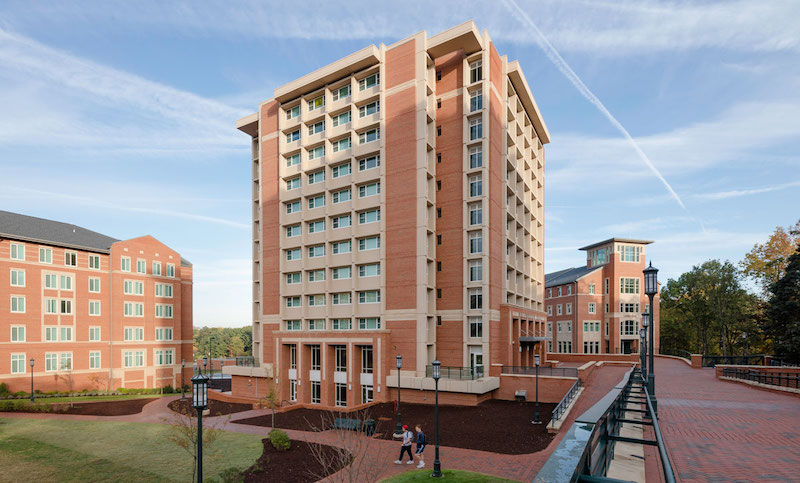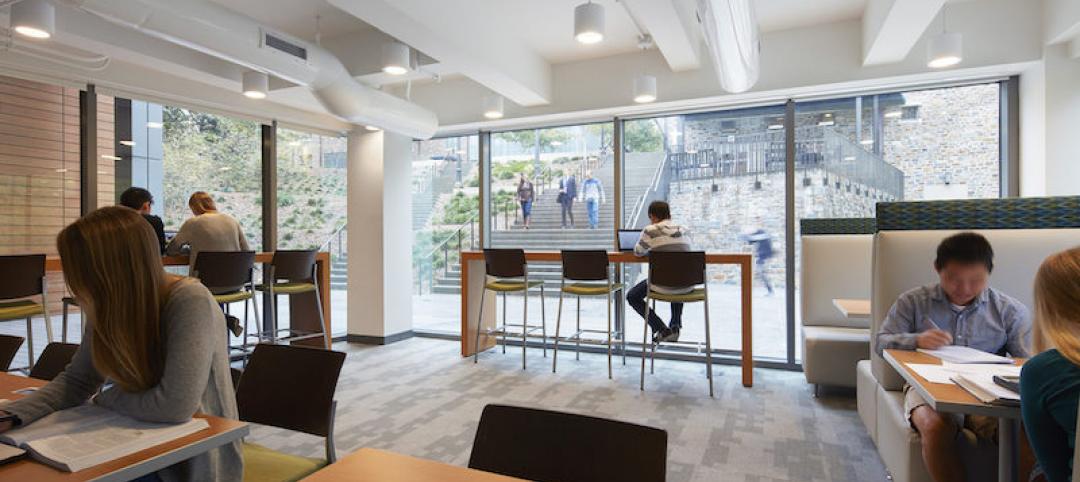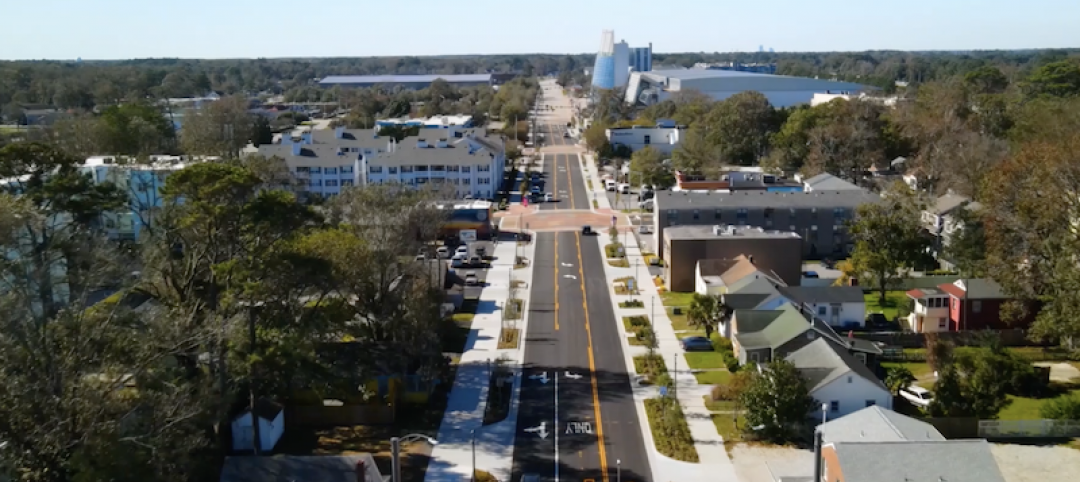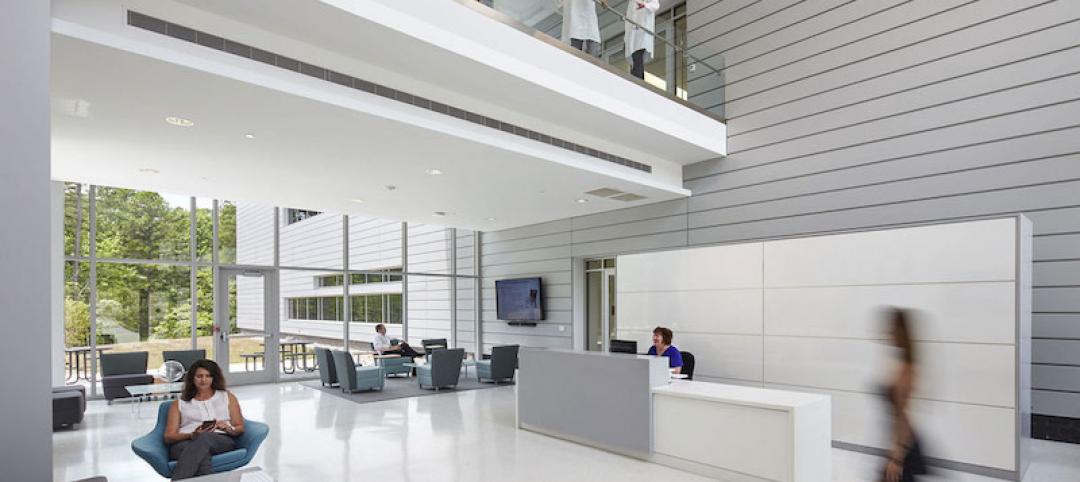Across the country, hospitals are facing either immediate or potential bed shortages as the COVID-19 pandemic grows. Efforts to expand healthcare capacity are coming from all corners: the USNS Comfort is docked in NY; the USNS Mercy is docked in CA; and the USACE is spearheading efforts in New York City and California to convert empty hotel rooms and student housing facilities into overflow hospital rooms.
State governors and hospital leaders are also working with colleges and universities to convert residential facilities for use as field hospitals or housing for out-of-town healthcare professionals coming in to care for patients. UNC Charlotte has offered six of its residence halls to meet the needs of the community, either as a field hospital or housing for healthcare professionals, as NC’s outbreak grows. One of those six is Holshouser, a high-rise dormitory that was renovated by Clark Nexsen in 2015.
It is clear that COVID-19’s impact on the AEC industry will be far reaching. Distance learning, remote work, and the need for emergency medical facilities may forever change the way these spaces are designed and used – and a new emphasis on serving the community, regardless of primary function, has emerged. These shifts have prompted our Student Life experts to consider: how can residence halls serve the greater good, now and in the future? Beyond the obvious bed count, what makes them uniquely suited, in these emergency circumstances, to being repurposed in times of community crisis?
Prior to joining Clark Nexsen, I worked for a firm that specialized in healthcare, so I’m aware of many essential components residence halls lack that are required for true healthcare uses. But there are ways in which residence halls meet today’s urgent need well, and perhaps more importantly, can become flexible to meet unanticipated needs better in the future.
What Works Well Now (Or Can Be Easily Modified)
There is a natural fit between higher ed residence halls and temporary healthcare use. Residence halls with double or single occupancy rooms are best suited for this purpose as they provide separation for patients with different health issues. In instances of infectious disease, this separation is critically important. Similarly, many of our recent designs provide residence halls with private bathrooms which work well for patient care since they typically have a private toilet, sink, and shower. Other items that are incorporated into our designs that are beneficial include overall barrier free designs, elevators that are already sized for stretchers, bathrooms with ADA accessibility, windows in every sleeping room, provision of robust internet capability, emergency power standby generators, temperature control in each room, wide corridors, and durable wall and floor finishes. In our current situation, the fact that these facilities are vacant and available for use during this crisis is a benefit to the community if needed for overflow.
One of the key hospital functions missing in a residence hall (but easily remedied) is a nurse station for each building wing. With high speed WiFi in every modern residence hall, it’s reasonable to expect that a nurse station could be set up in a student room or common space relatively easily with the required telemetric devices through wireless connections.
How Can Residence Halls of the Future Be More Adaptable?
If we were to specifically focus on ensuring residence halls could meet temporary healthcare needs in the future, we would consider changes like wider door openings (to accommodate gurneys and stretchers); the potential location of flexible spaces that could transform into nurse stations with physical and visual access to all the rooms on each floor; furniture selection for ease of sterilization (metal, plastics); and ensuring there are clear routes for vital functions such as food delivery, trash removal, and hazardous bio waste.
Beyond flexibility for healthcare, there are other community emergencies where residence halls may suddenly play a role in sheltering a new population. It isn’t realistic to meet every need in one facility, but it is possible to do our best to create residential solutions that are resilient to natural disasters, inclusive by design, and can serve as a safe haven when called upon.
I believe that, across the board, the COVID-19 pandemic will impact the way we design for higher ed clients. Those impacts are still largely unknown, but we can speculate that colleges and universities may consider designing their buildings to be more flexible and adaptable in case of emergencies. I think the end result could be that higher education institutions may rethink how their capital construction projects are designed and may want to partner with their local governments and healthcare providers to incorporate design elements that would be beneficial to the broader community in times of crisis.
More from Author
Clark Nexsen | Sep 30, 2024
The importance of selecting healthy materials for K-12 projects
Clark Nexsen interior designers Anna Claire Beethoven and Brittney Just, CID, IIDA, LEED Green Associate, share why it is imperative to specify healthy building materials in K-12 schools.
Clark Nexsen | Aug 1, 2024
How current and future trends are shaping the libraries of tomorrow
Over the last few years, public libraries have transitioned from being buildings that only store and lend books to being fully featured community centers.
Clark Nexsen | Apr 25, 2024
How pools can positively affect communities
Clark Nexsen senior architects Jennifer Heintz and Dorothea Schulz discuss how pools can create jobs, break down barriers, and create opportunities within communities.
Clark Nexsen | Oct 2, 2023
4 design strategies for successful K-12 magnet schools
Clark Nexsen's Donna Francis, AIA, Principal, and Becky Brady, AIA, share four reasons why diverse K-12 magnet schools require diverse design.
Clark Nexsen | May 17, 2023
Designing K-12 schools for students and safety
While bullying, mental health, and other acts of violence are all too common in schools today, designers have shown that smart and subtle preventive steps can make a big difference. Clark Nexsen’s Becky Brady shares how prevention and taking action at the design level can create safe and engaging learning environments.
Clark Nexsen | Jul 1, 2022
How to apply WELL for better design outcomes
The International WELL Building Institute (IWBI) cites attracting top talent, increasing productivity, and improving environmental, social or governance (ESG) performance as key outcomes of leveraging tools like their WELL Building Standard to develop healthier environments.
Clark Nexsen | Jun 3, 2021
What's next for workplace design?
Balancing personal space and the need for collaboration.
Clark Nexsen | Apr 1, 2021
The changing face of freshman and sophomore student housing
As part of a surge in new housing projects for freshman and sophomores, we are seeing increasing demand for double occupancy rooms and suite-style arrangements in both new construction and renovation projects.
Clark Nexsen | Feb 17, 2021
Best practices for streetscape design that cultivates community
Well-designed streetscapes provide a wealth of benefits for their respective communities.
Clark Nexsen | Oct 20, 2020
Best practices in S+T office design
Within the constraints of the typical COVID-19 office protocols, lab users face the additional challenge of working with hands-on processes, tight schedules, and shared resources.
















